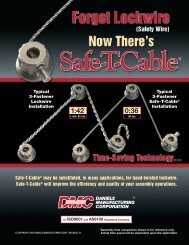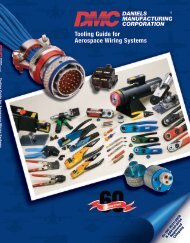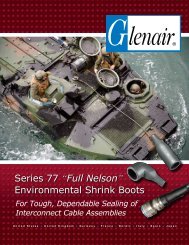High-Performance Micro-D Connectors and Cables - Pan Pacific ...
High-Performance Micro-D Connectors and Cables - Pan Pacific ...
High-Performance Micro-D Connectors and Cables - Pan Pacific ...
- No tags were found...
Create successful ePaper yourself
Turn your PDF publications into a flip-book with our unique Google optimized e-Paper software.
<strong>Micro</strong>-DSpecial Apps<strong>and</strong> MODs<strong>Micro</strong>-D Mod 429 Space GradeK2Screening: What is NASAscreening <strong>and</strong> what level ofscreening is required?What is NASA screening?NASA specification EEE-INST-002provides instructions on selecting,screening <strong>and</strong> qualifying parts for useon NASA GSFC space flight projects.Table 2C in the NASA spec containsspecific inspection instructions forMIL-DTL-83513 connectors. Thesescreening requirements exceed thest<strong>and</strong>ard mil spec inspection levels.What screening level is required?NASA defines three levels ofscreening: level 1 for highest reliability,level 2 for high reliability, <strong>and</strong> level 3for st<strong>and</strong>ard reliability. Level 3 equatesto st<strong>and</strong>ard M83513 Group A <strong>and</strong> B lotacceptance testing, <strong>and</strong> levels 1 <strong>and</strong> 2call for additional testing.Why does Glenair perform extrascreening tests?Glenair has test procedures that gobeyond the letter of the NASA spec.Meeting NASA requirements meansnot only inspecting per EEE-INST-002,but also building parts in accordancewith NASA Technical St<strong>and</strong>ard NASA-STD-8739.4 “Crimping, Interconnecting<strong>Cables</strong>, Harnesses, <strong>and</strong> Wiring”.Glenair fully meets these requirements<strong>and</strong> has obtained NASA certification.Our extra inspection steps reflect thefact that pre-wired connectors not onlyrequire best practices on the assemblyfloor, but also require thorough finalelectrical <strong>and</strong> mechanical testing.What about qualificationrequirements?Qualification is not required ifthe manufacturer has performedqualification testing per MIL-DTL-83513.Qualification by similarity is usuallyinvoked for those <strong>Micro</strong>-D’s notspecifically covered by the mil spec.Due to the dynamic nature of this document, users are advised to check thehttp://nepp.nasa.gov website prior to every usage to obtain the latest document revision.1.0 PURPOSEThe purpose of this document is to establish baseline criteria for selection, screening, qualification, <strong>and</strong>derating of EEE parts for use on NASA GSFC space flight projects. This document shall provide amechanism to assure that appropriate parts are used in the fabrication of space hardware that will meetmission reliability objectives within budget constraints.2.0 SCOPEThis document provides instructions for meeting three reliability levels of EEE parts requirements (see6.0) based on mission needs. The terms “grade” <strong>and</strong> “level” are considered synonymous; i.e., a grade 1part is consistent with reliability level 1. Levels of part reliability confidence decrease by reliabilitylevel, with level 1 being the highest reliability <strong>and</strong> level 3 the lowest. A reliability level 1 part has thehighest level of manufacturing control <strong>and</strong> testing per military or DSCC specifications. Level 2 partshave reduced manufacturing control <strong>and</strong> testing. Level 3 Parts have no guaranteed reliability controls inthe manufacturing process <strong>and</strong> no st<strong>and</strong>ardized testing requirements. The reliability of level 3 parts canvary significantly with each manufacturer, part type <strong>and</strong> LDC due to unreported <strong>and</strong> frequent changes indesign, construction <strong>and</strong> materials.GSFC projects <strong>and</strong> contractors shall incorporate this guideline into their Project EEE Parts Program.3.0 DEFINITIONSFigure 1: Excerpt from NASA EEE-INST-002Screening. Screening tests are intended to remove nonconforming parts (parts with r<strong>and</strong>om defects thatare likely to result in early failures, known as infant mortality) from an otherwise acceptable lot <strong>and</strong> thusincrease confidence in the reliability of the parts selected for use.Inspection/ Testtable 2: nasa screening requirementsNASALevel 1NASALevel 2Glenair Level 1(Mod 429B)Glenair Level 2(Mod 429)Visual Inspection 100% 100% 100% (10X) 100%Mechanical 2 pcs. 2 pcs. 100% 2 pcs.Voltage (DWV) 100% 2 pcs. 100% 100%Insulation Resistance 2 pcs. 2 pcs. 100% 100%Low Level ContactResistanceContact Separation Force(pins only)2 pcs. 2 pcs.100% (Read <strong>and</strong>Record)2 pcs. (Read <strong>and</strong>Record)N/A N/A 100% N/AMating Force 2 pcs. N/A 2 pcs. N/AContact/Wire Retention N/A N/A 2 pcs. N/ASolderability/Resistance toSoldering Heat2 pcs. N/A 2 pcs. N/ANotes:1. NASA screening requirements from Table 2C of EEE-INST-002.© 2011 Glenair, Inc. U.S. CAGE Code 06324Printed in U.S.A.GLENAIR, INC. • 1211 AIR WAY • GLENDALE, CA 91201-2497 • 818-247-6000 • FAX 818-500-9912www.glenair.comK-8E-Mail: sales@glenair.com









